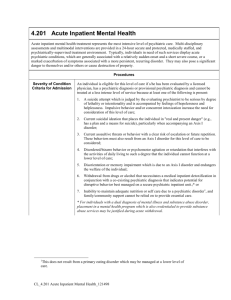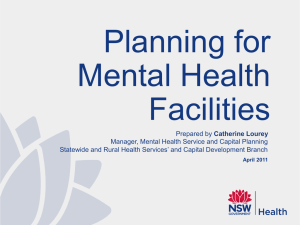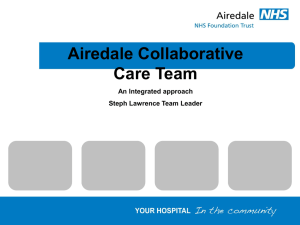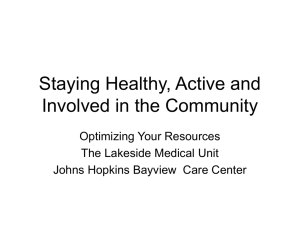Acute mental health care: briefing note Policy Unit, Royal College of
advertisement
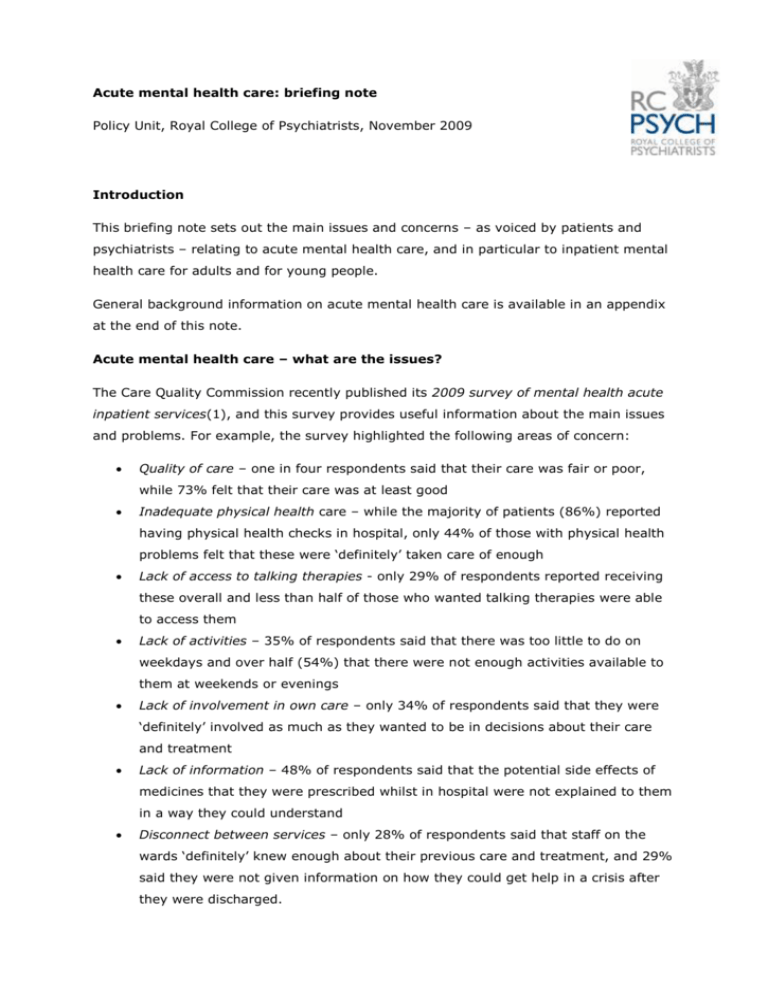
Acute mental health care: briefing note Policy Unit, Royal College of Psychiatrists, November 2009 Introduction This briefing note sets out the main issues and concerns – as voiced by patients and psychiatrists – relating to acute mental health care, and in particular to inpatient mental health care for adults and for young people. General background information on acute mental health care is available in an appendix at the end of this note. Acute mental health care – what are the issues? The Care Quality Commission recently published its 2009 survey of mental health acute inpatient services(1), and this survey provides useful information about the main issues and problems. For example, the survey highlighted the following areas of concern: Quality of care – one in four respondents said that their care was fair or poor, while 73% felt that their care was at least good Inadequate physical health care – while the majority of patients (86%) reported having physical health checks in hospital, only 44% of those with physical health problems felt that these were ‘definitely’ taken care of enough Lack of access to talking therapies - only 29% of respondents reported receiving these overall and less than half of those who wanted talking therapies were able to access them Lack of activities – 35% of respondents said that there was too little to do on weekdays and over half (54%) that there were not enough activities available to them at weekends or evenings Lack of involvement in own care – only 34% of respondents said that they were ‘definitely’ involved as much as they wanted to be in decisions about their care and treatment Lack of information – 48% of respondents said that the potential side effects of medicines that they were prescribed whilst in hospital were not explained to them in a way they could understand Disconnect between services – only 28% of respondents said that staff on the wards ‘definitely’ knew enough about their previous care and treatment, and 29% said they were not given information on how they could get help in a crisis after they were discharged. In November, the National Mental Health Development Unit (NMHDU) will launch a National Acute Care Declaration. The Declaration will aim to engage leaders, managers and practitioners to drive up the quality of acute care and collectively respond to the issues highlighted in The Pathway to Recovery(2) and the Care Quality Commission’s Survey of acute mental health inpatients.(1) Adult inpatient care – what are the specific issues? Bed numbers and bed occupancy. In the period 2002-2003 to 2007-2008, total numbers of mental health beds fell from 32,753 to 26,928, a reduction of 17%. According recent data from AIMS, the Accreditation for Inpatient Mental Health Services programme run by the Royal College of Psychiatrists’ Research and Training Unit, the majority of inpatient wards exceed the recommended level of 85%. Of 110 of the wards enrolled with AIMS who provided data, the average occupancy was 98%. 52% had bed occupancy levels greater than 100%, while 16% met the recommended level of 85% occupancy. According to figures from the Mental Health Act Commission,(3) ‘over 2005/06 and 2006/07, 37% of all the acute wards that we visited were running at over 100% occupancy, and a further 27% of acute wards were fully occupied. In the following two financial years [i.e. 2007-2009], 30% of acute wards were over-occupied, and 27% were running at full occupancy.’ These figures are therefore at odds with official Department of Health ones which report that, for the year 2007-2008, there were 26,928 mental health beds, of which 86% were occupied (23,244). In the year 2006-2007, there were 27,913 mental health beds, of which again 86% were occupied. Bed occupancy rates are generally calculated as the number of patients assigned to a ward (whether these are physically present on the ward or not) divided by the number of beds on that ward. Therefore a ten-bedded ward with ten patients ‘on its books’ has an occupancy of 100%; if the ward had eight patients its occupancy would be 80%. Wards can have an occupancy rate of greater than 100% if patients assigned to particular beds are ‘on leave’ (i.e. on ‘supervised discharge’, under section 17 of the Mental Health Act). Members of the College report that so-called ‘leave beds’ are re-used routinely with the general assumption (or hope) that patients will not need to return. However, one result of this is that patients become insecure about going on leave, since they know that in reality they are effectively being discharged. Characteristics of inpatient community, and threshold for admission – one effect of the undoubted effectiveness of crisis resolution and home treatment teams’ in reducing numbers of inpatients is that wards now have a more disturbed population of patients than before, and yet staffing levels have not been adjusted to reflect this. ‘The knock-on effect of the reorganisation on the acute in-patient wards has been substantial. The increase in the relative number of patients staying for longer periods, detained, and with psychotic disorders has clear implications for in-patient staff, the therapeutic environment and most importantly the experience of patients.’(4) The role therefore of the acute ward needs to be better defined (its function can tend to be a mix of care, containment and accommodation), as currently it can be a dumping ground for people whose community care has broken down.(5) Early discharge – while a small amount of anecdotal evidence exists that some patients are discharged too early,(6) some disquiet has been voiced by psychiatrists that there is pressure to discharge patients early (due to bed occupancy issues). The Mental Health Act Commission note that while in some areas crisis resolution and home treatment services are working to facilitate an earlier discharge from acute psychiatric wards, the impact of this approach ‘has yet to be explored’.(7) Findings from the CQC survey of inpatient care(1) show that 24% of patients felt they were not given enough notice of their discharge from hospital; it may be that pressures relating to occupancy explain these patients’ experience of a lack of adequate planning concerning their discharge. Delayed discharge - There are still patients who remain in hospital longer than necessary due to lack of move on accommodation. Delayed discharges result in penalties for local authorities if they occur from general hospitals but not from mental health wards. The need for inpatient beds – one (often unstated) aim of developing/strengthening crisis resolution/home treatment teams is to make savings by closing acute beds. However, there needs to be an acknowledgement on behalf of policy-makers and service managers that there will always be a need for inpatient beds. Furthermore, money can be saved by providing excellent and timely care to people who need admission. This will hasten discharge and reduce readmission rates. Non-therapeutic environment – the issues described above can result in staff having little or no time to deliver talking therapies, wards placing too great an emphasis on pharmacotherapy and providing poor physical health care. Wards can therefore be dangerous and chaotic, with staff always ‘fire-fighting’, with violence common and absconding everyday occurrences.(5) Over-emphasis on community developments – jobs in community teams are seen as more glamorous and better paid; wards are seen as recruiting ground for the community posts. Pressures from ward size reduction - in many areas wards need to reduce in size (the Royal College of Psychiatrists’ report Not Just Bricks and Mortar (http://www.rcpsych.ac.uk/files/pdfversion/cr62.pdf) recommends an optimum size of between 10-15 beds). It is not easy to achieve this however without increasing bed occupancy, unless issues around delayed discharge issue are resolved and are sufficient to account for the reduction in beds. Child and adolescent acute mental health care – what are the specific issues? Studies(8;9) carried out by the Royal College of Psychiatrists’ Research and Training Unit have highlighted the following issues: Admissions of young people to adult psychiatric wards – in the four months between 3 October 2008 and 28 February 2009, 80 under-18 year olds were admitted to adult psychiatric facilities.(3) These figures compare to 132 between October 2004 and November 2006. (10) Of these 80 young people, 59 were admitted to mixed-sex wards, while nine were not assigned their own room. With the exception of one male patient, all those admitted to single-sex wards had their own room. Transitions to adult services – as adult services generally have a much higher threshold than CAMHS services, young people who reach the upper age limit of CAMHS services find it difficult to access appropriate support from adult services. Lack of social work input – too few units meet the appropriate level of social worker input and many have no input at all. This can lead to delays in young people being discharged (and therefore new admissions being accepted) and also means that the social care needs of young people are not being met. Lack of psychology input – too few units have the appropriate level of input from a psychologist, which can limit young people’s access to psychological therapies Lack of emergency provision – too few units are able to admit young people at severe risk in an emergency. Appendix General information about acute mental health care Acute mental health services work with people who are experiencing, are at risk of, or are recovering from a mental health crisis. These people may be adults, older people, young people, people with learning disabilities, mothers and babies, or offenders. Historically, inpatient services provided the mainstay of acute care provision. However, in 1999, the National Service Framework saw the introduction of Crisis Resolution and Home Treatment teams which aimed to reduce inappropriate admissions and overcrowded wards, and facilitate earlier discharge. Acute care mental health services comprise the following key elements (see below for definitions/remit): crisis resolution and home treatment teams respite care crisis house provision inpatient beds/wards psychiatric intensive care units place of safety provision step-down and supported housing provision, and a range of other services with links, direct and indirect, to acute care. Care is provided on the basis of acute care pathways, which refer to the journey that service users make from initial referral to discharge from acute services. Crisis resolution/ home treatment team (CRHT): a mobile multidisciplinary team operating 24 hours, 7 days a week, which provides treatment at home for those acutely unwell but not requiring admission, gate-keeps (assesses the appropriateness of) inpatient admissions and facilitates early supported discharges. It is recommended in the policy implementation guidance (DH, 2001, 2006) that a standard CRHT of 14 staff covers a population of 150,000. While home treatment constitutes the major part of a CRHT’s workload, the team should also provide intensive support to help people be discharged from inpatient care earlier than would otherwise have been possible. Respite/Crisis house provision: in some areas CRHT can also access and support people in crisis beds for those who cannot be treated at home but do not need to be admitted to hospital. This provision is usually made in ordinary supported housing in partnership with local voluntary or social care organisations. Inpatient beds: are an essential part of an integrated acute care pathway, intended to provide a high standard of humane treatment and care in a safe and therapeutic setting for service users in the most acute and vulnerable stage of their illness. Admissions are considered where this would play a necessary and purposeful part in a person’s progress to recovery from the acute stage of their illness. Acute day treatment services: provide an alternative to admission for people who are acutely unwell and are a means of facilitating early discharge and preventing readmission. Acute day treatment services may be provided as an integral element of an acute hospital unit or as a standalone facility. Psychiatric intensive care unit (PICU): part of the overall acute service which provides a more intensive level of inpatient support and intervention for those people exhibiting high levels of agitation or disturbance, as well as for those who maybe particularly vulnerable. PICUs usually serve a wider catchment area population than a CRHT or admission ward. They can be sited as a stand alone unit adjacent to other mental health inpatient facilities or as a ward within a larger unit. (DH, 2002) Place of safety provision: a small suite of rooms for the emergency psychiatric assessment of those detained by the police under s.136 of the Mental Health Act. These have often traditionally been located in police stations, but it is now considered far more appropriate to site them within mainstream healthcare adjacent to or as part of an acute unit (revised MHA Code of Practice DH, 2008). Step-down and supported housing accommodation: some services find it helpful to develop partnership arrangements with voluntary and independent sector providers to ensure patients’ discharge from acute care is not inappropriately delayed. Other services: depending on the local context, other services will link, directly or indirectly, the acute care pathway to services such as: o Accident and Emergency/liaison services o Acute medical wards o Primary care services o Early intervention services o Drug and alcohol services o Assertive outreach services o Police (particularly in relation to Section 136 of the 1983 Mental Health Act). Reference List (1) Care Quality Commission. Mental health acute inpatient service users survey 2009. 2009. (2) Healthcare Commission. The pathway to recovery: a review of NHS acute inpatient mental health services. 2008. (3) Mental Health Act Commission. Coercion and consent: monitoring the Mental Health Act 2007-2009. The Mental Health Act Commission Thirteenth Biennial Report 2007–2009. The Stationery Office; 2009. (4) Keown P, Tacchi M, Niemiec S, Hughes J. Changes to mental healthcare for working age adults: impact of a crisis team and an assertive outreach team. Psychiatric Bulletin 2007;31:288-92. (5) Lelliott P, Bennett H, McGeorge M, Turner T. Accreditation of acute in-patient mental health services. Psychiatric Bulletin 2006;30:361-3. (6) Griffiths R. The patient's experience. Mental Health Today 2008;13-5. (7) Mental Health Act Commission. Coercion and consent: monitoring the Mental Health Act 2007–2009. London: Stationery Office; 2009. (8) O'Herlihy A, et al. National In-patient Child and Adolescent Psychiatry Study . 2001. (9) Tulloch S, et al. The Costs, Outcomes and Satisfaction for Inpatient Child and Adolescent Psychiatric Services (COSI-CAPS) study. 2009. (10) The Mental Health Act Commission . Risk, Rights and Recovery. Twelfth Biennial Report 2005–2007 . The Stationery Office; 2008.
